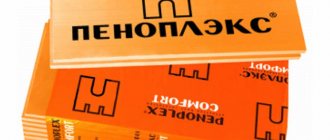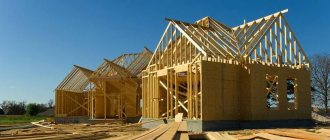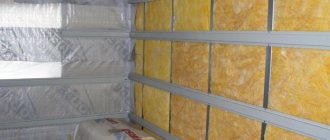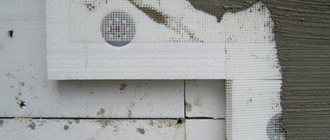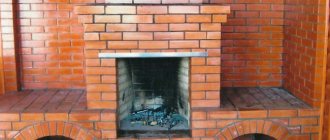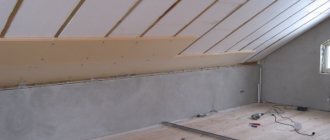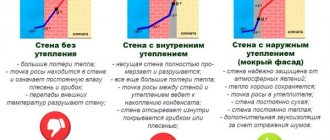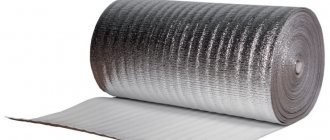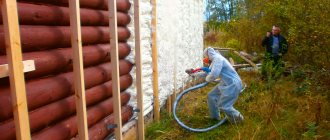The article was prepared with the participation of specialists from the Association of Expanded Polystyrene Manufacturers and Suppliers
The market for thermal insulation materials is represented by various categories, which greatly simplifies the selection of suitable insulation for specific tasks. One of the most popular insulators in the private sector is polystyrene foam; its popularity is explained by both its high technical characteristics and availability. Nevertheless, battles between supporters and opponents do not subside around it; it is quite difficult for a person far from construction to figure out which of the properties of insulation are real and which are from the category of “horror stories”. We will try to make the task easier for beginners, and it will be useful for more experienced craftsmen of our portal to refresh the information. And specialists from the Association of Expanded Polystyrene Manufacturers and Suppliers will help you separate the “wheat from the chaff.”
Consider:
- What is polystyrene foam?
- Main characteristics of expanded polystyrene.
- Scope of application of expanded polystyrene.
Internal and external insulation
Before you start insulating the walls, you need to decide on the insulation method. Laying insulation outside or inside is an individual preference. Each method has its own advantages and disadvantages . The features of each insulation method must be studied at the time of building design.
Insulation from the inside
Internal wall insulation is characterized by the following features:
- the cost of insulation from the inside is less than that of external insulation;
- season and weather do not affect the choice of time for work;
- there is no need to build additional scaffolding for insulation work.
Negative factors for internal insulation are:
- significant reduction in living space;
- the outer wall is insulated from heating from the room;
- the likelihood of fungus forming inside the wall increases, since the dew point is formed precisely in the inner part of the structure;
- when the heating is turned off, the walls quickly cool down due to the low inertia of the insulation;
- the junction of the ceiling with the external wall cannot be equipped with insulation, which leads to the formation of cold bridges.
The method of insulating walls from the outside is more popular despite the fact that the cost of labor and materials for performing the work is significantly higher than the method of internal insulation.
Dew point
Insulation from outside
The advantage of insulating walls from the outside is:
- in winter and in cold weather, heat is retained in the wall for a long time;
- the design area of the room is preserved;
- external thermal insulation protects internal walls from dampness.
In addition, the external walls are additionally protected from weather conditions, which significantly increases the service life of the structure.
The main disadvantages of external thermal insulation of a structure are:
- restriction of work in accordance with weather conditions;
- increase in costs for materials used.
Which side of the wall to insulate with polystyrene foam?
It is advisable to insulate walls with expanded polystyrene from the outside, since the material does not allow air to pass through, which can lead to the formation of condensation inside the wall during internal insulation, and also inside the room the material can emit a specific odor.
Properties of EPP
Surprisingly, this unique material demonstrates a combination of qualities that people could only dream of before.
- There is practically no water absorption: even when the slabs are completely immersed in water, it only lasts for the first 10 days. Since the cells of the substance are sealed, water in none of its states can pass inside, filling only the side open “honeycombs”.
- Low thermal conductivity of EPP (much less than that of other insulating materials.
- Greater fragility and less ductility compared to foamed polystyrene.
- The ability of a material to transmit light.
- High compressive strength.
- Frost resistance, not subject to rotting.
- Resistance to chemicals: water, acids, oils, caustic alkalis, saline solutions, bleach, alcohol and alcohol-based dyes, fluorinated hydrocarbons, cement, ammonia, CO2, propane, acetylene, butane, paraffin.
- Safety for humans.
Application diagram for extruded polystyrene foam in construction
Advantages and disadvantages of expanded polystyrene
The polystyrene foam material is a porous, air-containing raw material , used in most cases as a heat-insulating material.
In industry, the material can also be used as electrical insulating and packaging material.
The material has become widely used due to its quality indicators:
- low level of water absorption;
- low thermal conductivity;
- ease;
- biological stability;
- durability;
- compressive strength;
- not affected by temperatures;
- ease of installation;
- low price of material.
Comparison of insulation materials
Despite the impressive list of positive indicators, polystyrene foam has disadvantages that must be taken into account during installation:
- low sound insulation;
- instability to solvents and many chemicals;
- afraid of fire. When burned, it releases harmful toxic substances;
- poor resistance to ultraviolet radiation;
- easily susceptible to the influence of rodents and insects, which, by making holes in the material, provoke its destruction;
- low vapor permeability;
- fragility.
IMPORTANT!
Expanded polystyrene is sometimes compared in terms of characteristics and external indicators with another similar material - polystyrene foam.
However, the production technology of these materials is different : polystyrene foam is produced by extrusion, when the granules melt when combined into a single structure, polystyrene foam is produced by gluing granules with dry steam.
Specifications
Briefly about the main thing
We can say about the EPS board that it is a universal thermal insulation material for all structural elements of buildings. It retains heat perfectly, insulates noise, is not afraid of water and weighs almost nothing. But its scope of application is limited by two factors: toxicity when heated and very low vapor permeability, due to which expanded polystyrene is not recommended for insulating wooden houses. The quality of the material depends on strict adherence to the production technology regulated by GOST. And its installation is quite simple and accessible even for beginners in construction.
Types of expanded polystyrene
Expanded polystyrene is classified according to the method of production of the material and the inclusion of various additives in it:
- pressed polystyrene foam . Produced by pressing;
- pressless polystyrene foam . Produced by removing moisture by drying and then foaming at high temperatures;
- extruded polystyrene. Not much different from pressless; an extruder is additionally used in production. The best and optimal option for thermal insulation of walls.
There are other types of polystyrene foam (extruded, autoclaved), but they are not used as insulation materials because they have different characteristics.
In addition to types of expanded polystyrene, there are also various types of insulation, such as:
- mineral wool;
- penofol;
- penoizol;
- penoplex;
- polyurethane foam.
Video description
Since not all manufacturers indicate this parameter, you need to be able to determine it yourself.
How to do this is shown in the video: The quality of products also varies and depends on the manufacturer’s compliance with manufacturing technology. Some introduce harmful additives into raw materials or do not use recommended components. Sometimes ordinary polystyrene foam is sold under the guise of EPS. To be sure of quality, you should buy certified products manufactured not according to the manufacturer’s technical specifications, but according to GOST.
Advice! You can verify good quality by performing a simple test. You need to break off a piece of material and inspect the fracture site - small regular polyhedra should be visible on it, not balls.
Depending on the place of application, choose slabs with a stepped edge or a corrugated surface, which facilitates the application of a plaster layer on it.
Wall pie when using insulation - polystyrene foam on the outside
A wall pie refers to layers of materials that are laid in a certain order, each of which performs its own functions to ensure a normal microclimate in the room.
When thermally insulating brick walls with polystyrene laid outside, the wall pie looks like this:
- interior plaster;
- outer wall;
- adhesive solution for gluing polystyrene foam;
- insulation (expanded polystyrene);
- adhesive solution for gluing the next layer;
- fiberglass mesh;
- adhesive composition;
- primer;
- finishing plaster.
NOTE!
When arranging a wall using polystyrene foam, it is necessary to lay the layers in strict sequence.
Internal and finishing plaster can be replaced with other finishing materials that are provided for in design solutions.
Wall cake "wet"
Where is EPS used?
The material described is used in a variety of fields, but we are interested in what EPS is in construction. This is a universal thermal insulation material that is used to insulate almost all parts of buildings:
- walls;
- foundations and plinths;
- floors and ceilings;
- basements and undergrounds;
- roofs;
- blind areas.
It is recommended to insulate EPS walls from the outside or use it as an intermediate layer when laying walls made of bricks and blocks.
Insulated brickwork Source bitrix24.ru
For external wall insulation, both ordinary EPS boards are used, which are then covered with plaster or a curtain wall, as well as decorative sandwich panels that do not require finishing.
It is important! If the house is insulated from the inside with polystyrene foam boards, it is necessary to take into account their low vapor permeability and consider a competent ventilation system. Otherwise, the indoor air will be humid, which will lead to mold.
In addition to insulating the main structural elements of buildings, slabs and other products made from EPS are used for thermal insulation of above-ground and underground pipelines, wells, septic tanks, caissons, cellars, and heated greenhouses. This material is laid on a rough base when installing a heated water floor, and is used as permanent formwork in the construction of foundations and walls.
Thermal insulation substrate for heated floors made of polystyrene foam Source fis.ru
Issues of vapor barrier and waterproofing
An important requirement during the construction and improvement of a house is the correct implementation of all work to ensure ventilation and waterproofing, since it is the incorrect installation of these components that significantly reduces the performance of the structure.
When insulating walls with polystyrene, waterproofing is not needed . It should be taken into account that if there is a high passage of groundwater under the building, it is necessary to waterproof the basement and foundation.
Since polystyrene foam does not allow air and water to pass through, there is no need to lay a vapor barrier layer when insulating walls from the outside.
Wall insulation cake under siding
How to choose EPS insulation
The main parameters by which the material is selected are the density, size and configuration of the slabs.
Technical specifications
The density of polystyrene foam is an important criterion for selection. The larger it is, the stronger the slab and the greater the load it can withstand without deforming. Products with the highest density are even used in the construction of roads and runways.
The bulk of such products for universal use have a density from 25 to 45 kg/m3; in the marking it is indicated by the corresponding numbers. But there are products of both higher and lower brands. The higher the expected load on the insulated base, the greater this indicator should be.
For example, for insulation of plinths and foundations it is better to choose material of grade 35-40 and higher, but for roofs 25 is sufficient.
Sealing cracks and preparing sheathing
Installing polystyrene foam on the sheathing is the most labor-intensive process among the insulation options. Most often, sheathing is done in the case of finishing siding.
Sealing cracks
If you plan to install siding on the wall of a house made of beams, you must first seal the seams properly, clean the surface of dust and debris, and seal the cracks with sealants, polyurethane foam, or a mixture of sawdust and PVA.
If the wall is concrete, brick or foam blocks, then the cracks in such houses are cleaned of sand, treated with a primer, then sealed as follows :
- if there is a small gap . Using a prepared mixture of cement and sand with the addition of PVA, seal the gap with a spatula;
- if the gap is medium in size . Make holes for dowels at a distance of 20 cm. Using screws and washers, pull the metal mesh over the gap and seal it, pressing it into the mesh with plaster. Next apply the finishing layer;
- for a large crack . Seal the gap with polyurethane foam, cut off any irregularities and seal it with two layers of plaster.
Large cracks can be repaired using anchors:
- knock down the plaster, seal the cracks with polyurethane foam;
- install a channel in the opening and attach a reinforcing mesh to it;
- you can use staples made of reinforcing mesh;
- apply plaster;
- putty.
Sealing cracks
When the wall is prepared for laying insulation, you can install the sheathing.
Preparing the sheathing
The sheathing for siding can be made from metal profiles and wooden beams . In humid climates, it is advisable to install metal slats.
Before you begin installing the sheathing, you should determine the location of the siding:
- with horizontal siding . The beam or metal profile is installed perpendicularly;
- with vertical siding . Frame boards or metal profiles are installed in a horizontal position.
The pitch of the sheathing is determined by the width of the polystyrene foam sheet: in width it should fit tightly between the sheathing slats and not form gaps.
The order of work is determined in steps:
- treat the wall with special mastic;
- frame boards are secured around the entire perimeter of the walls using galvanized screws and plastic dowels;
- if holes form between the timber and the wall, these gaps are sealed with pieces of polystyrene foam by gluing them to the wall.
When the sheathing is installed, then proceed to the installation of polystyrene foam panels.
CAREFULLY!
If the sheathing is made of wood, the boards must be pre-treated with antiseptic agents.
Lathing does not require special skills, but it should be noted that the choice of materials should be made based on climate conditions.
Lathing for siding
Wooden sheathing
Video description
Watch a video about roof insulation over solid flooring:
On the formwork
To make permanent formwork from extruded polystyrene foam slabs, you will need special plastic ties with which the opposite walls of the formwork are fastened to each other and fixed at a certain distance.
The design of the ties allows you to change this distance and has special sockets for fixing the reinforcement cage bars.
Mounted formwork with a steel frame Source homemasters.ru
How to cut EPS
When carrying out thermal insulation work, EPS boards often have to be cut, cutting out pieces of the desired shape and size. Since the material is quite soft, this can be done with a knife, the main thing is that its blade is very sharp, durable and thin, otherwise the material will crumble.
Advice! To get rid of the strong squeaking noise that accompanies cutting, the knife blade can be periodically moistened with machine oil.
Another suitable tool for cutting is an angle grinder (simply an angle grinder) with a metal disc. The thinner it is, the less debris and dust will be generated, and the cleaner the cut will be.
There are also special tools for cutting foam plastic that work on the principle of thermal cutting - special machines and “hot knives”.
Thermal cutter for polystyrene foam Source allegroimg.com
It makes no sense to buy such equipment for one-time use, especially since a cutting machine can be made with your own hands from nichrome wire stretched between two driven nails. To make the wire glow, the nails are connected to a transformer and voltage is applied to them.
It is important! The thermal method of cutting polystyrene foam can only be used in the fresh air or when using personal protective equipment such as a respirator or gas mask, since when it is heated, toxic substances are released that can be harmful to health.
Homemade machine option Source pochini.guru
Technology of wall insulation with polystyrene from the outside
Before you begin insulating the wall with polystyrene foam, you should dismantle the gutters, decorative elements, clean and prime the wall. Next, insulate the sills and window slopes.
Now let's talk about the thickness of polystyrene foam.
NOTE!
When insulating walls with extruded polystyrene, sheets are used whose thickness ranges from 80 to 100 mm or more.
You can also use thinner sheets 30-40 mm thick if they are laid in two layers.
Let's start installing insulation on the walls with our own hands:
- a profile is installed at the bottom of the wall to hold polystyrene foam;
- the adhesive mixture is applied to the wall over the entire area in spots and onto the insulation sheet (amply on the center and edges of the sheet);
- tightly attach the sheet for gluing to the wall;
- Use dowels to secure the panel so that the dowel penetrates the wall at least 50 mm. The dowels are placed in the center of the panel and at the joints. It is recommended to use plastic nails;
- if gaps form (up to 2 cm), then they are sealed with polyurethane foam , if the gaps are larger, then they are first sealed with pieces of insulation, and then foamed. Excess foam is cut off;
- The heads of plastic nails are cleaned and puttied.
After installing the insulation, a reinforcing mesh is applied to the façade . You should cut strips of mesh at the corners and slopes and glue them with a spatula using an adhesive composition. An adhesive composition is applied to the mesh along the wall so that it penetrates 0.1 cm through the mesh onto the polystyrene foam. If an overlap occurs, separate strips of mesh are placed on it and additionally glued.
Sectional view of the device
Fastening slabs with dowels
Application of assembly adhesive
After the surface has completely dried, it is leveled with fine granulation sandpaper.
Next, the surface of the walls is covered with putty and a finishing decorative coating . External insulation with polystyrene foam, when installed correctly, will provide comfort and warmth in the house.
Installation features
Knowing why extruded foam is needed, what it is and what positive characteristics it has is completely insufficient if you decide to install it yourself. The method of fastening depends on the type of insulated surface.
On the floor and blind area
When insulating horizontal surfaces, polystyrene boards do not require fastening. They are laid on a leveled surface - a floor slab or a sand cushion. When installing an insulated blind area or concrete screed, it is recommended to reinforce the concrete layer on top of the insulation with steel mesh.
If the insulation of a wooden floor is carried out followed by the laying of laminate, linoleum and other finishing coatings, then a wooden frame made of bars is first installed on the base, and EPS boards are laid between them. Sheets of plywood or OSB are fixed to the frame.
All joints and seams are filled with foam Source tetrapilon.ru
On the walls
EPS can be attached to vertical surfaces in different ways.
- Gluing.
The slabs can be glued to mineral substrates - to smooth walls made of brick, concrete, building blocks using special adhesives. Many manufacturers of extruded polystyrene foam also produce glue for their installation. In particular, TechnoNIKOL and Penoplex have them. But in construction stores you can find adhesive mixtures of other brands.
Polystyrene foil mats
Foiled polystyrene foam with markings
FPS is able to increase the overall energy efficiency of the facility, retain heat, and significantly reduce the cooling properties of the cement foundation on which the floor covering is installed due to its high sealing characteristics.
The solution to the problem of creating a warm floor today is FPS profile slabs. They have high mechanical strength. On top they are covered with a rigid vapor barrier film. Their surface has a special molding, which allows for reliable and convenient fastening of heating pipes of different diameters. They are laid hermetically, thanks to the side locks, reliable adhesion of the structure is ensured, which eliminates the divergence of the seams. An additional ruler is applied to the sides of the slabs for convenient adjustment of the elements; the embossed lower surface smoothes out unevenness of the flooring and helps absorb noise.
Non-flammability, environmental friendliness and how long does it last?
Construction raw materials called polystyrene foam serve for a long period of time. It does not lose its original characteristics. Various tests have confirmed that it can be used repeatedly, and the quality does not decrease as a result. Expanded polystyrene contains special components. They are called fire retardants. Due to this composition, the material has a low flammability rate. But to say that it does not ignite at all would be wrong.
Insulation of a house from the outside Source realstroyservice.kiev.ua
Let's go through the personalities
Let me move away from the traditional algorithm for talking about building materials, which usually begins with their undeniable advantages, and in conclusion, in small print, briefly mentions the dialectically inevitable shortcomings. We will proceed from the opposite: we will start with the most problematic quality, and then we will go progressively to a description of the actual advantages of the material.
Flammability
When it comes to using extruded polystyrene foam, one always remembers its flammability.
Indeed, cheap fakes of this material have a flammability class of G3 and even G4. Simply put, it is a fire hazard. However, in recent years, chemist-technologists have found a way to raise the flammability class of the material to G1 (low-flammability). For this purpose, special flame retardant additives are added to the composition. In the event of a fire at the dacha, such material no longer poses a direct threat. And one more mandatory condition for the safe use of polystyrene foam, and the most important thing is the correct design of a country house building. In a technically competent project, polystyrene insulation is located in places where flames cannot reach in the event of a possible fire. That is, if we use polystyrene slabs in the foundation, in the basement, when insulating the floor of the first floor or blind area, the fire hazardous properties of the material are practically nullified. If polystyrene slabs are laid in the foundation, plinth, or blind area, their fire hazard properties are practically nullified. Photo by the author In general, these building structures are considered fireproof, because insulation boards are never used in them openly.
Vapor permeability
It's practically zero. Somewhere in the foundation, when waterproofing a concrete structure, this is a necessary condition, a functional trump card of a modern material. However, if we mentally move above the zero mark and insulate and line the outer side of the load-bearing wall with this material, then the wall will immediately stop “breathing.” One can only sympathize with the summer residents who moved outside the city precisely for the sake of fresh air, and as a result found themselves under a polystyrene “cap”. If your plans do not include keeping the windows open 24 hours a day 365 days a year, already at the design stage of the dacha you need to provide for the construction of a supply and exhaust ventilation system, at least the simplest one. So, is zero vapor permeability good or bad? A rather incorrect question, to which, nevertheless, there is a technically competent answer: use extruded polystyrene foam strictly for its intended purpose, then there will be no price for this quality!
Water absorption
This is the most important characteristic for materials used below “zero”, that is, in the ground.
The fact is that many heat insulators require additional protection from moisture when working in the ground. Many, but not extruded polystyrene foam. Its water absorption varies, depending on the manufacturer, from 0.2 to 0.4% of the volume (technical data sheet data). Moreover, these figures were not taken out of thin air, but from the test report, which was carried out according to the GOST EN 12087-2011 standard “Thermal insulation products used in construction. Methods for determining water absorption during long-term immersion.” Technical characteristics of extruded polystyrene foam But for an ordinary summer resident, far from the subtleties of the characteristics of building materials, it is difficult to imagine what this 0.4% is. Let's look for a figurative comparison. If we count in the usual liters, then from 1 liter of water in contact with the surface of the insulating slab, 4 (four) ml will penetrate into it in a month! This is less than a teaspoon in volume! Take note: extruded polystyrene foam does not require additional waterproofing, and therefore no costs for it.
Thermal conductivity
This is the strongest, trump card parameter of the material: thermal conductivity at 25±5°C, no more than 0.032 W/(m*K). In practice, this is one of the best indicators in the construction industry for widely used thermal insulators. For example, the thermal resistance of extruded polystyrene foam 3 cm thick and red brick masonry 56 cm thick are equivalent! Frankly, there are thermal insulators with smaller parameters, but for the most part they fly into space. In terms of thermal conductivity, extruded polystyrene foam is one of the best thermal insulators in the construction industry

